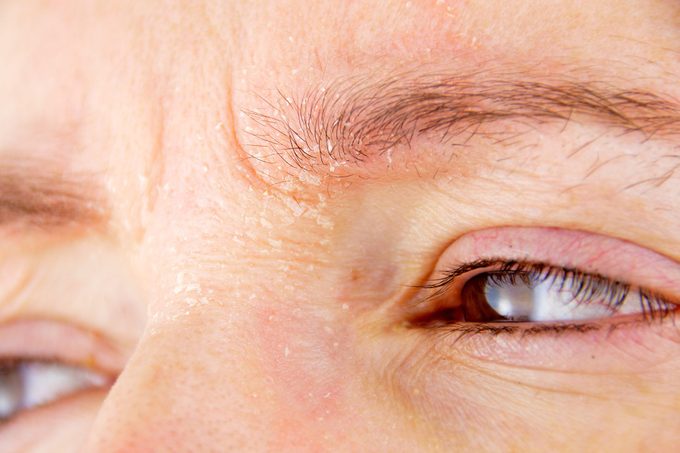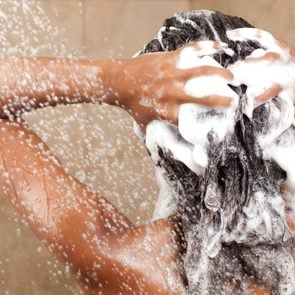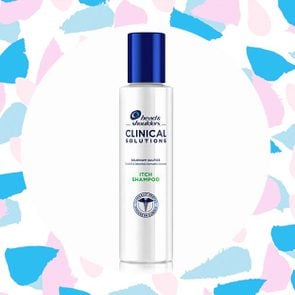Yes, Eyebrow Dandruff Is Real—Here’s How to Treat It
Updated: Jul. 02, 2021
If you're dealing with flaky eyebrows, chances are you have eyebrow dandruff. Learn what causes it and how to get rid of it.
Our editors and experts handpick every product we feature. We may earn a commission from your purchases.
What is eyebrow dandruff?
Those white flakes clinging to your eyebrows may be more than just an annoyance or embarrassment. They could be a sign of a medical condition known as seborrheic dermatitis.
Approximately 3 to 5 percent of the population deals with the condition, according to the American Academy of Dermatology (AAD). And about half of them report dandruff, either on their scalp, their eyebrows, or both.
Seborrheic dermatitis creates patches of red, oily, flaking skin in areas rich in sebaceous glands, particularly the scalp, face, and body folds, explains Shani Francis, MD, a Los Angeles-based dermatologist and a chief wellness officer for Ashira Dermatology.
The flakes, caused by the shedding of skin, are what you know as dandruff. And they can occur anywhere on the body with hair, including the head and eyebrows.
“Seborrheic dermatitis is not generally contagious or spread to others,” says Dr. Francis, who serves as the chair of the AAD’s performance measurement committee. “But medications, environmental conditions, and stress may worsen it.”
To effectively manage eyebrow dandruff from seborrheic dermatitis, dermatologists recommend a combination of over-the-counter and prescription medications, as well as lifestyle changes to keep it in check.
What causes eyebrow dandruff?
Researchers are still studying what causes seborrheic dermatitis. But they do know that the hair follicles aren’t the biggest player, even though dandruff occurs on areas of the body with hair. It’s about the oil-producing glands under the skin.
“Even people who shave their heads still get dandruff,” says Rebecca Kazin, MD, board-certified cosmetic dermatologist and director of clinical research for Icon Dermatology and Aesthetics in Rockville, Maryland. “It’s more of an issue with sebum production and yeast by-products.”
While genes, climate, and medications are all suspects, it is the naturally occurring yeast on your skin that plays a key role.
For unknown reasons, Malassezia yeast can overgrow, leading to inflammation that triggers the rash associated with seborrheic dermatitis. The skin under the eyebrows is a big draw for yeast.
“Yeast tends to prefer the more oily areas of skin, [including the] scalp and eyebrows,” explains Dr. Francis. “The skin reacts to the inflammation by creating dandruff.”
Eyebrow dandruff vs. dry skin
While dry skin can cause flaking beneath the eyebrows, it’s not the same thing as eyebrow dandruff. Dry skin may affect your whole face, including the eyebrows, and won’t appear red or rash-like.
Seborrheic dermatitis of the eyebrows, however, is marked by patches of red, flaking skin. The flakes will be larger than dry skin flakes, and oily.
It’s also not the same as eyelid psoriasis, which can affect the area around the brows.

Who is most at risk?
Let’s clear something up straightaway: most of the time, how clean you are has nothing to do with why you have dandruff. Dr. Francis says even people with exceptional hygiene may still have eyebrow dandruff.
People of all genders, races, and ages can develop the condition. But it’s most common in infancy and middle age, according to research conducted by the National Institutes of Health.
In infants, it appears as a condition called cradle cap. In adults, it comes with red, scaly patches and dandruff.
While the majority of infants outgrow cradle cap, most adults will have recurring bouts of seborrheic dermatitis into their 60s.
Specific groups of people are more susceptible to the skin condition, says Dr. Francis. This includes those with neurological conditions (like multiple sclerosis, Parkinson’s disease, and epilepsy), heart conditions, and immunodeficiency syndromes like HIV.
Although only a small fraction of people have seborrheic dermatitis, about 85 percent of people with HIV do, according to the AAD.
Medications can also increase risks, notes Dr. Francis. These include medications applied directly to your skin for conditions such as acne, rosacea, or psoriasis, which may make your skin more oily or irritated.
What is the treatment for eyebrow dandruff?
There is no cure for eyebrow dandruff caused by seborrheic dermatitis, according to the AAD. Daily care should be focused on keeping the scalp and eyes clean to lessen the occurrence. (More on the dandruff shampoos that may help later.)
If you can’t prevent flare-ups, you can at least manage the symptoms with prescription and over-the-counter (OTC) treatments.
Getting a correct diagnosis is key to finding a treatment that works. Not all flaky skin and irritated eyebrows are caused by the same thing, says Dr. Kazin.
Your best bet is to get a proper diagnosis from a medical professional.
A single episode that goes away on its own, or with one treatment, may be something else. But eyebrow dandruff that occurs frequently, when the weather changes or your stress levels rise, is likely seborrheic dermatitis.
Since eyebrow dandruff and seborrheic dermatitis are one and the same, you’ll treat them similarly. But Dr. Francis says special care should be taken for products applied to the face, whether they’re prescription strength or OTC.
Prescription medications
Dandruff on the head often migrates to the eyebrows. Dr. Francis typically prescribes a shampoo with 2 percent ketoconazole, which can also be used as a facial cleanser to target the brows.
“This is often easier for patients to navigate since it is a “wash off” type of treatment,” she adds.
Also effective: sulfur-based products, which you’ll find in cream, lotion, and cleanser forms. Not so hyped about that rotten-egg smell? Prescription options are available which are less “odorous,” Dr. Francis says.
“For especially severe conditions, topical steroids can be prescribed,” she says. “However, long-term use of topical steroids can cause problems, such as skin thinning and ‘steroid addiction.'”
OTC products
“We have to live in the reality that access to health care is not [universal],” says Dr. Kazin, who has many patients who treat their eyebrow dandruff with products found on their drugstore shelves. “[Eyebrow dandruff] is relatively harmless, and an effective treatment may be found over the counter.”
You’ll probably recognize a lot of the OTC options, and they work just the same when used to wash your eyebrows.
Dr. Kazin has seen good results with products containing pyrithione zinc (Head and Shoulders), selenium sulfide (Selsun Blue and Head and Shoulders Clinical Strength), miconazole (Selsun Blue Medicated), and coal tar (Neutrogena T-Gel).
The drawback, she mentions, is these chemicals can be harsh on your hair, stripping natural oils and actually accelerating dryness, which can lead to more dandruff.
If that’s the case for you, a foam-based or liquid product may be better options in the long term.
Dr. Francis, who practices holistic medicine, has had good results with olive oil, which naturally dissolves the scales that lead to dandruff.
A diet rich in fruits and vegetables
A 2018 study published in Nutrients suggests that adding fruit fiber to your diet may help reduce the risk of seborrheic dermatitis.
The study says prebiotic fruit fibers may promote a healthy microbiota, leading to “lower systemic inflammation and better immune function.” Veggies didn’t have the same effect.
Sources of fruit fiber include fresh berries, avocados, apples, pomegranates, and dried apricots, cranberries, prunes, dates, and figs.
What happens without treatment?
Ignoring eyebrow dandruff won’t make it go away, says Dr. Francis. And the longer it sticks around the more likely you are to deal with side effects like hair and pigment loss.
Physical impacts like these can be reversed, but recurring bouts of eyebrow dandruff can affect emotional health and feed the cycle of depression, she says.
“Board-certified dermatologists are available nationwide and can help those suffering with this condition achieve skin health,” she says.




















